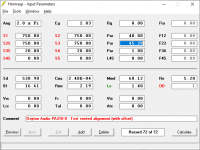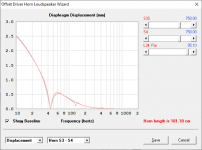In the grand scheme of professional concert production, using a 3dB more efficient bass system below 100Hz makes almost no difference compared to the energy expended in lighting, video walls, heating and cooling the venue, and transporting the system, artists, technicians, stagehands and patrons to the venue.I have to say that in my experience the fact that the 218 BR is the standard weapon of choise is a bit curious, in these days having a sustainable and environmental approach as a core part of your business is a given, this tends to mean that the most efficient solution is getting the most focus.
In that light how can it be a good idea to have set on a solution that requires roughly twice the power and twice the amount unorganic material to do the job?
I can also say after decades of experience, trying to convince an artist's production manager that a system using half the drivers and power can produce the same output is an uphill battle, regardless of it's "sustainability".
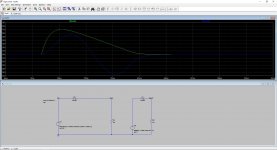
What exactly would you call a true transient?
Here is a simple sinewave and a non-sinusoidal transient through a simple 6dB lowpass filter.
If you run a FFT on the low pass filtered transient you still get a lots of harmonics.
Since it is a discontinues and non sinusoidal signal, it does contain lots of harmonics and it takes a much faster bass driver and amp then the simple filter would indicate to recreate this signal. You would need a 10 kHz capable bass driver and amp to create this low passed signal within -90dB accuracy, while the sine wave makes do with a few hundred Hz capable amp.
What exactly would you call a true transient?
I don't see a real problem in hiding...makes no sense so far.
A sub contributes it's share of transient response, the portion within its freq domain. If it contributes beyond that range, through distortion, over excursion, etc, then not good.
Have you ever pulsed a sub alone with just a dirac pulse? And tried to audibly compare one sub vs another? It's damn hard to evaluate a sub's transient response when it's the only driver playing.
There is nothing i can see to give one type box al great advantage over the others, if they are truly well designed.
The only types i would say have an advantage are both sealed, .....sealed itself and FLH.
yes. You missed impedance without frequency or freqiency without impedance.
Now put that into a half wave and you bulge in the middle.
Now we see ROAR. I think his discroptions of punchy are modest
Imagine i divergence in phase from the middle out? Now a transient or high /low in middle change?
Looks like quicker or closer at vector of phase aligned. But gets worse out to the ends of bandwidth.
depending on the dimensions of roar or paraflex alt, theres a high pass filter acoustically or theres output in the middke
Last edited:
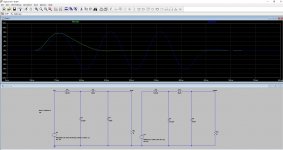
Here is the same transient and a 3 cycle burst of sine waves put through a 24 dB/octave 120 Hz -3 dB point filter.
The transient still has a lot more higher harmonics then the sine wave. And it is easy to see that the sine wave have a small but noticeable build up time through a slightly resonant filter like this.
A BR box will have a lot more build up time then this since the port resonance has a much higher Q.
The airmass inside a bass reflex box is not the same as a lever. It is a spring, not mechanically coupled. It is quite hard to get a directly coupled lever to resonate without adding some kind of elasticity into the system.
Look at the group delay graph of a BR. There is definitely some delay around the port tuning.
If feedback networks did corrects the errors instantaneously then why do you need to limit the bandwidth of a high gain amp with negative feedback to avoid oscillation?
Yes, and if you take a sealed box and EQ it to have the same frequency response as the ported box, the group delay curves will match. That means a Helmholtz Resonator does not have any inherent delay beyond that introduced by the shape of the LF rolloff.
Both systems (sealed and ported) are minimum phase.
The analogy of a lever isn't perfect, but I do think it illustrates my point.
Chris
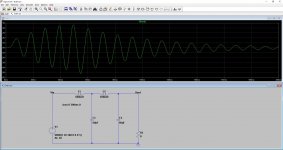
The bass reflex box is usually described as a resonant 4th order system.
Here is 5 cycles of a 100 hz sine wave fed through a resonant 4th order low pass filter.
A very pronounced build up of resonance.
I don´t know how to simulate the electric equivalent of a true loudspeaker driver in a bass reflex box in LTSpice, so this is just my best try at the moment. If anyone knows how to simulate all the different losses, friction etc etc, then please share your model so we can have some valid data to discuss.
What exactly would you call a true transient?
I don't see a real problem in hiding...makes no sense so far.
A sub contributes it's share of transient response, the portion within its freq domain. If it contributes beyond that range, through distortion, over excursion, etc, then not good.
Have you ever pulsed a sub alone with just a dirac pulse? And tried to audibly compare one sub vs another? It's damn hard to evaluate a sub's transient response when it's the only driver playing.
There is nothing i can see to give one type box al great advantage over the others, if they are truly well designed.
The only types i would say have an advantage are both sealed, .....sealed itself and FLH.
View attachment 906003
Here is the same transient and a 3 cycle burst of sine waves put through a 24 dB/octave 120 Hz -3 dB point filter.
The transient still has a lot more higher harmonics then the sine wave. And it is easy to see that the sine wave have a small but noticeable build up time through a slightly resonant filter like this.
A BR box will have a lot more build up time then this since the port resonance has a much higher Q.
Can we refer to capacitance as compliance and inductance as mass loaded? If so its helmholtz and mass loaded TL in a nut shell? In this case maybe Roar vs Hroar? i think MJK would agree? though the tapped entry would put him off, on compounded he has shared a similar idea with me.. TL /bass reflex rear vented. And i had ‘paraflex/roar morph
since ‘compliance’, maybe it shoulda been Vass reflex
Last edited:
Yes, and if you take a sealed box and EQ it to have the same frequency response as the ported box, the group delay curves will match.

This might be true but the impulse response does not match at all.
The port response simulation and the closed box simulation is not perfectly matched (I am too tired to get them any closer at the moment), but the impulse response is very far from matched. The port impulse response graph have a really nasty sharp edgy "curve" and the EQed closed box has a much more smooth and nice curve.
Last edited:
I'm sorry to hear that, and I do get the small part it plays in the total machinery economically and consumption wise, yet every step one can take should be taken, I am not that big on environmental issues beyond recognizing that it should be considered, efficiency is simply put a part of proper engineering, so I definitely think that if there are more efficient solutions (which there definitely are) then one better get cracking on solving the other issues that might be associated with that, not doing so will in the long run leave you at the *** end of the competition, regardless of what business you are in.I can also say after decades of experience, trying to convince an artist's production manager that a system using half the drivers and power can produce the same output is an uphill battle, regardless of it's "sustainability".
Please stop with this nonsense. You don't have a clue about amplifiers and negative feedback.If feedback networks did corrects the errors instantaneously then why do you need to limit the bandwidth of a high gain amp with negative feedback to avoid oscillation?
if you take a sealed box and EQ it to have the same frequency response as the ported box, the group delay curves will match
This might be true in simulation or even at steady state tones measured at low power levels.
Since a loudspeaker is very far from a nice linear device and a real life bass reflex box will have port compression and turbulence among many other nonlinearities, one does not need to push this very far to see the reality deviate from the perfect theoretical EQ-closed-box -same-GD idea.
A 15TBX100 doing full peak to peak excursion in a small closed box will not behave the same as the driver doing 1 mm cone excursion at port tuning in a large bass reflex box, even though we can EQ the spl response to look similar and get a similar GD as a response to a simple sine wave sweep.
... What's wrong with a sine sweep?
The only reason we use simulations is because they're a close match to reality.
If you can actually demonstrate the effect you're hypothesising, I'd be very interested to see the measurements.
Chris
The only reason we use simulations is because they're a close match to reality.
If you can actually demonstrate the effect you're hypothesising, I'd be very interested to see the measurements.
Chris
If you can actually demonstrate the effect you're hypothesising
This is why I am posting some simulations and trying to get some feedback on them.
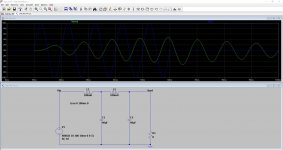
I will try again.
If the bass reflex box is a forth order resonant system then why would there not be any build up of resonance amplitude, when an forth order resonant electrical circuit clearly shows that there is???
I guess I must miss something here since everyone keeps on telling me that the forth order resonant bass reflex does not have a build up time of the resonance amplitude while LTSpice clearly shows it does.
I am certain that my model is wrong in some (many) ways, so please post a better electrical analog to a loudspeaker driver in a forth order resonant bass reflex box.
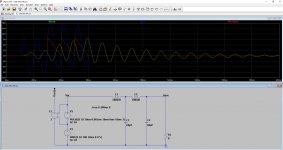
I will use this oversimplified model as long as I don´t have anything better.
Here is the Vout response (green) from the Vin (total of V1 and V2) signal (blue) and the Voutpart (red).
If the bass reflex can be described as a fourth order system and there is even the slightest correlation between an electric forth order resonant filter and the Helmholtz resonator, then a bass reflex box should exhibit these properties to some extent.
My model is exaggerated (I hope!) to make these properties easier to see, and I am very keen to get a more appropriate model to use as a base for these simulations and this discussion.
This models also shows quite clearly why the driver of a bass reflex box will be pushed offset by a transient from a kick drum.
Please show me some simulations or real life measurements of why I am wrong and how this does not apply.
What's wrong with a sine sweep?
Among the drawbacks with a simple sine sweep is that it will not provoke an displacement offset (not centered around the zero crossing) in the driver. It might still do this if the bass reflex port terminus is very asymmetric between inside and the port outlet, but that will be a quite gross design flaw and not something inherent in the bass reflex design itself.
Music does not have much in common with a single slowly increasing frequency sine wave.
But don´t me wrong. There is a place and an use of the sine sweep. I do use it often and it does tell me a lot about the design.
The problem is that it is very difficult or at least very expensive to inject a sudden single cycle offset squarewave into a loudspeaker at work, where there is a lot of stored energy in the walls of the box, the port and in the form of cone velocity and bell modes in the cone etc etc etc - and then compare this reproduced single cycle offset square wave with the original. It does take a lot of quite advanced filtering and measuring equipment. But this would probably tell me a lot more about the performance of a loudspeaker reproducing complex material then the use of a sine sweep.
I'm not convinced this is true. I've used many BR boxes, and dropped a lot of power into them, and never once seen them bottom out on the first half-cycle (or whatever), for the port to then restrict cone excursion.
Helmholtz resonance does not take a few cycles to take effect: they are, in fact, minimum-phase systems with the same time domain performance as a sealed box with the same frequency response.
I'd still like to see compression performance of a ROAR design: that narrow section looks suspect to me.
Chris
+1
Higher order systems often have a number of resonances themselves, that if not properly damped or dealt with during design can be quite nasty indeed.
Last edited:
In addition to the other reasons that have been mentioned for BR popularity...I would add output density to the list. This is the way the industry has been trending. More bass from less space. Power is cheap.
There is another possible reason no one has mentioned yet.
Also I find nothing wrong sonically with a well designed BR sub system. If BR is most popular by far it stands to reason that there are a ton of mediocre and just plain bad designs out there by default. When I see blanket statements about BR sounding a certain way it makes me wonder if the commenter has ever heard a good, well setup BR sub system.
There is another possible reason no one has mentioned yet.
Also I find nothing wrong sonically with a well designed BR sub system. If BR is most popular by far it stands to reason that there are a ton of mediocre and just plain bad designs out there by default. When I see blanket statements about BR sounding a certain way it makes me wonder if the commenter has ever heard a good, well setup BR sub system.
View attachment 905992
Here is a simple sinewave and a non-sinusoidal transient through a simple 6dB lowpass filter.
If you run a FFT on the low pass filtered transient you still get a lots of harmonics.
Since it is a discontinues and non sinusoidal signal, it does contain lots of harmonics and it takes a much faster bass driver and amp then the simple filter would indicate to recreate this signal. You would need a 10 kHz capable bass driver and amp to create this low passed signal within -90dB accuracy, while the sine wave makes do with a few hundred Hz capable amp.
I can't see how it matters what the FFT gives for harmonics of such a transient. The only harmonics the sub is asked to produce are those that fall within it's bandwidth, and post xover at that.
I don't know how you low-pass a sub, but I always use much steeper than 6dB octave. (I don't have group delay or phase issues due to using linear phase xovers.)
Anyway, i tried to go past simming a pulse like you show, and see how it measures...was in this post https://www.diyaudio.com/forums/sub...-produce-single-cycle-sine-9.html#post6287766
You can see the FFT and read my take/measurements on the sub's output and harmonic spillover to upstream drivers, going back to #73 and #80.
(bolserst's posts in that thread are really good stuff...i think they began at post#72)
Bottom line, i don't think what you're saying applies to a sub's limited bandwidth
Last edited:
In addition to the other reasons that have been mentioned for BR popularity...I would add output density to the list. This is the way the industry has been trending. More bass from less space. Power is cheap.
There is another possible reason no one has mentioned yet.
Also I find nothing wrong sonically with a well designed BR sub system. If BR is most popular by far it stands to reason that there are a ton of mediocre and just plain bad designs out there by default. When I see blanket statements about BR sounding a certain way it makes me wonder if the commenter has ever heard a good, well setup BR sub system.
Since everyone else is argueing ‘why not’ and why, can i ask a hypothetical Q in regards to phase aligned thats not economic or conveniently oriented?
A compound TL shape using a tapped driver at the middle and start of a two part system each 1/4 of it has a fold and the motor entry is at 0, and 180, the folds are at 90 and 270. 360 is the exit.
If thats somehow then used in a way that is a lit of qw extensions and output we all know, or have found in a sim of offset driver, then compound offset , then tapped offset, etc. is there something in this thats more than the biggest badest or hifiest, or bassiest?
I keep finding ways to get phase closer at the ends, and then even from
The middle, i use all kinds of ideas from roar chambered , huge tapped pipe, double TL compounded as paraflex, straight csa but offset driver with offset port exit...
i keep making the wide and even ‘loud’. But also im
Finding i can remove the little pesky squiggles in response, that are also found in harmonics that then get swept under the carpet or ignored by agendas that need to oat my bills or satisfy a customer or whatever.. we are all
In a rush! It cant be helped...
But why is there a simmable result (thats big) that requires a very good motor and a very tight tolerance in the spaces folded and positions if them, which means no flare rate or taper that is almost(?) perfect in a sim??
split up and propelled in a quadrant of two series paths each bisected by a folded CSA impedance LO filter or the driver tapped entry or the actual exit?
Is that it? Its just too big and the details are too hard in the corners and harmonics are chaos in a ‘room’ of it anyhow?
All thus decay and impulse aside, vented vs sealed, etc.
no chambers or add ons? Whats left after the sinewave is used as the sinewave?
A simple experiment - set up the Hornresp sim that is illustrated in the attached image, which emulates a cylindrical vented alignment with a small hole cut in a end panel to act as a vent. Now, using Loudspeaker Wizard, enlarge the "hole" by increasing S3 and S4, and then lengthening L34 to shift Fb back downwards to match its original value (use the Loudspeaker Wizard's "Displacment" graph as a guide to doing this). You'll notice that, until the "vent" gets basically to the same CSA as the rest of the enclosure, there is very little change in the driver's displacement.
So, what does this little exercise show? Well, unless there is some error in the Hornresp sim, there is basically no significant difference between a driver's displacement behaviour in a vented box and its behaviour in a simple "quarter-wave" design with the same Fb. Because yes, once the vent's CSA is the same as the CSA of the cylinder, it is now a quarter-wave "pipe".
Which of course leads to the question - at what point in that exercise did the sim shift from being a vented alignment to a quarter-wave radiator alignment? 🙂
So, what does this little exercise show? Well, unless there is some error in the Hornresp sim, there is basically no significant difference between a driver's displacement behaviour in a vented box and its behaviour in a simple "quarter-wave" design with the same Fb. Because yes, once the vent's CSA is the same as the CSA of the cylinder, it is now a quarter-wave "pipe".
Which of course leads to the question - at what point in that exercise did the sim shift from being a vented alignment to a quarter-wave radiator alignment? 🙂
Attachments
- Home
- Loudspeakers
- Subwoofers
- Design principle diversity below 100Hz in professional applications
